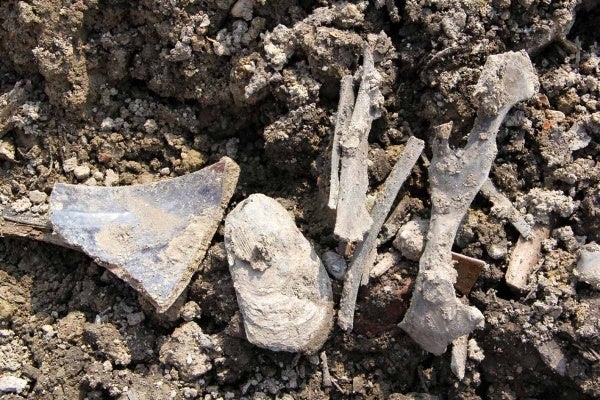Digging along the Delaware for remains of 17th century carousing
It’s now just a parking lot, with weeds sprouting through cracked asphalt.
But 350 years ago, this block on the west side of Columbus Boulevard, between Vine and Callowhill streets, used to be the river’s edge.
“We know this was the river, built out over time. And buildings put on top of the built land. So there’s a chance that any of the remains are now below water,” said industrial archaeologist Tim Mancl, peering into a fresh, 6-foot-deep trench with several inches of water seeping in. “The tide comes up about 5 feet. So that’s our main problem. It’s hard to work where there’s lots of water.”
Mancl, of John Milner Associates, is excavating this plot at the behest of the Delaware River Waterfront Corporation. A 1987 excavation revealed remains of a shipyard under the asphalt. A few slips used to move river sloops in and out of drydock. This dig is moving farther away from the river, to see if there are remains of any structures.
The DRWC wants a better sense of what is underground, for its waterfront development plan. Right now, there are no immediate plans to build on the property.
Structures predate William Penn’s arrival
That earlier excavation found physical evidence of a maritime business owned by John West, dating back to at least 1676, before the arrival of William Penn. Penn founded Pennsylvania in 1681.
West also owned a tavern, the Penny Pot. Something may still be left in the Pot, under the asphalt.
“A large trash deposit. That’s what I want to find,” said Mancl. “I’m pretty sure we’re going to find the building foundations. But what we really want to find is what people left behind. What they threw out, essentially. So we want information about what was going on in the tavern.”
What was going on in that tavern was probably no good, morally. It’s tawdry reputation has survived three centuries.
“That was the first red-light district of the New World,” said Harry Kyriakodis, author of “Philadelphia’s Lost Waterfront.”
“A lot of prostitution, a lot of gambling dens, so it was a rough and tumble tavern,” he said. “It was not a genteel tavern like what the City Tavern came to be known as.”
The tavern may have disappeared centuries ago, but it still has fans. A current neighbor along Water Street built a replica of it on top of his row house. The peaked-roof tavern lives today as an over-sized pilot house straining to see the river.
For a few days, public can take a peek
The archaeological dig is a short one. At barely two weeks, it’s just enough to get a quick read before it’s all covered up again with dirt and asphalt. During a small window of time the public is invited to peer into the 17th century.
At least four open trenches will be available for passers-by to see Wednesday through Friday. Three archaeologists will be actively digging out artifacts as people watch.
“What we find is exciting, we want to share that excitement,” said head historian Rebecca Yamin. “When you write about it, it’s not the same as being in the presence of remnants of the past. Archaeologists get that experience … it’s nice to bring the public in that experience too. There’s nothing like it.”
WHYY is your source for fact-based, in-depth journalism and information. As a nonprofit organization, we rely on financial support from readers like you. Please give today.








